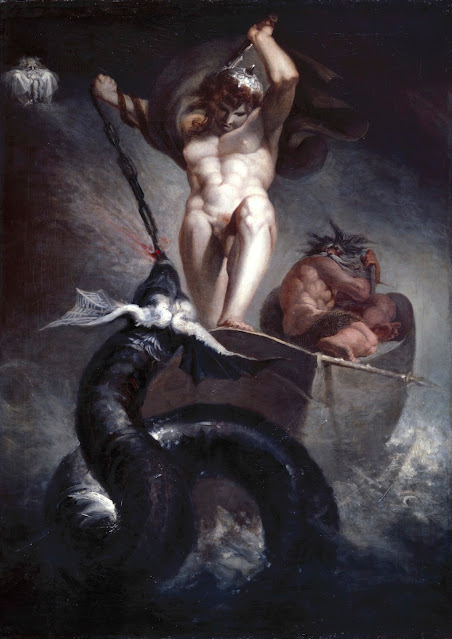Thor Battering the Midgard Serpent by Henry Fuseli (Interpretation and Analysis)
 |
| Thor Battling the Midgard Serpent Source: Wikimedia Commons |
Thor Battering the Midgard Serpent is one of Fuseli’s most memorable paintings. Created as his diploma piece for entrance to the Royal Academy, the piece depicts a story from Norse mythology. Here, we see the Norse god Thor doing battle with the monstrous serpent Jörmungandr. According to legend, Jörmungandr—one of Loki’s children—encircled the whole world. In one tale, Thor went fishing with the giant Hymir and accidentally snared Jörmungandr. When the serpent rose to the surface, the god and the monster did battle, with Jörmungandr eventually escaping Thor and returning to the depths.
Thor Battering the Midgard Serpent captures the battle in this story. Here, we see Thor standing in the prow of Hymir’s boat pulling the serpent out of the water with his fishing line. On his other hand, Thor holds the hammer Mjölnir above his head, preparing to strike. Meanwhile, Jörmungandr writhes in the dark, turbulent water. Hymir cowers in the back of the boat, while, in the top left corner, the god Odin observes the fight. The background of the painting is a wash of black and grey, suggesting a storm is brewing (very appropriate weather for the god of thunder).
Fuseli’s style in this piece is bold and energetic. He uses light, shadow, and color to convey energy and movement in his paintings. Fuseli’s compositional choices are also unique. The viewer experiences the painting as if they are at the bottom of the scene, looking up. Thus, Thor towers above the viewer in larger-than-life splendor. The dark, muscular coils of the serpent provide a clear contrast with the god. Although the original Norse legends rarely pass moral judgement on anything, Fuseli presents the battle as a struggle between good and evil.
Indeed, many art historians have interpreted the piece as an allegory for the French revolution, which was just beginning when Fuseli created his epic piece. Scholars posit that the serpent represents the aristocracy while muscular Thor is a stand in for the French people.
Fuseli’s choice to paint a scene from Norse mythology was unusual at the time. These legends were only translated into English in 1770 (although Fuseli probably knew them from an earlier French work), making the story of Thor’s fishing trip a relatively new addition to the collective English imagination and cultural consciousness. Therefore, it was an unconventional choice to choose a Norse subject for his diploma work during a time when scenes from English and Classical history were much more popular subjects.
However you choose to interpret it, Thor Battering the Midgard Serpent is certainly a dramatic and visually powerful piece that marks Fuseli as a bold and singular artist.



Comments
Post a Comment